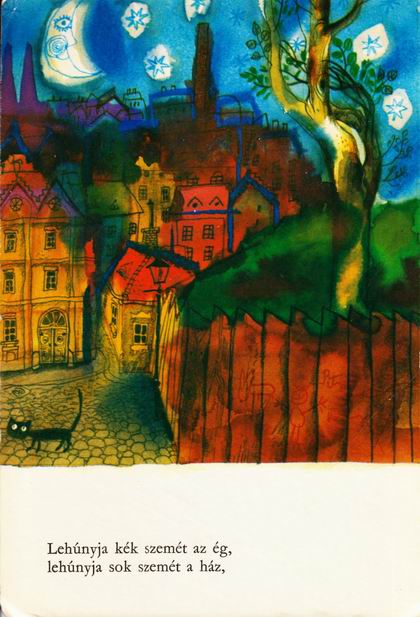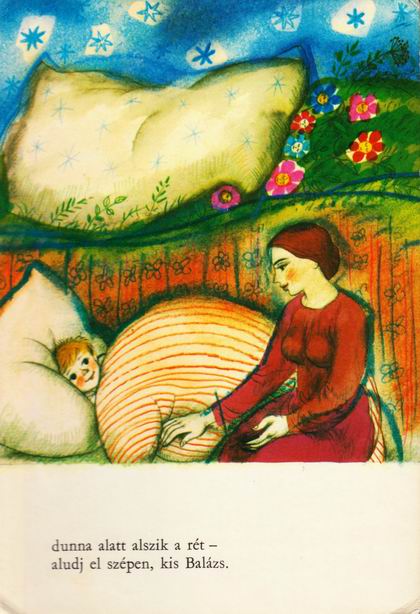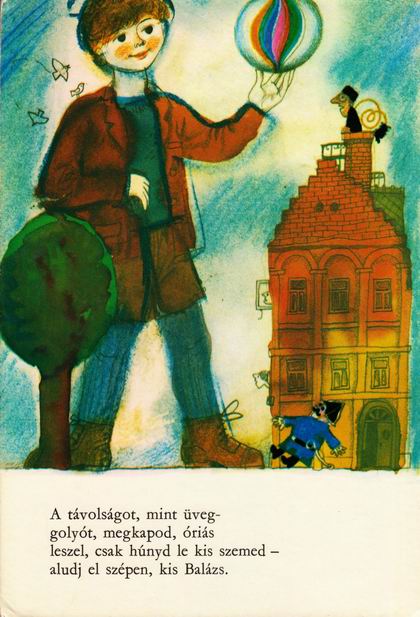so here we are, it goes indeed incredibly slow. the document finally stamped on 25 January was sent over in a few minutes in e-mail. true, I also had no time to press the thing. I hope we will be able to organize it all. many enthusiastic diggers are wanted for a close weekend. I will write announcements in the staircases (unfortunately the majority of the most enthusiastic helpers have already left the country).
Monday, January 30, 2012
Wednesday, January 25, 2012
earth!
I have just been called from Főkert to check in details on what kind of earth I intend to order, and they have promised an e-mail. Sometimes it turns out that maybe I’m just too impatient to the Mediterranean tempo of the Hungarians.
Leaves of the fabulous tree
photo by Tibor Mester
View Angyalföld in a larger map |
For example
Lullaby for children: (move the mouse over the poems for the English translation)



The strange adventures of the little Greek boy and little Turkish girl reduced to the size of a little finger in the island of Cyprus
And for adults:
The nostalgic-painful narrative by Sholem Alechem on a love rooted in the childhood, a beautiful fragile little story built of almost-happenings
To Wilde
thanks to the Medicina publisher, the Anangaranga enriched the extremely poor erotic book publishing of the Kádár era. The text is likely to have disappointed many readers, but the colorful illustrations with the women dawning in pearl color were really well done
thanks to the Medicina publisher, the Anangaranga enriched the extremely poor erotic book publishing of the Kádár era. The text is likely to have disappointed many readers, but the colorful illustrations with the women dawning in pearl color were really well done
Books illustrated by Ádám Würtz:
Sólem Áléchem, ÉNEKEK ÉNEKE, Európa, 1959.Vermes Magda, HOLDFÉNY – klasszikus elbeszélések, Móra, 1962.Szederjei Magda, AZ ÖSVÉNY TITKA, Móra, 1964.William Shakespeare SZENTIVÁNÉJI ÁLOM, Magyar Helikon, 1972.Hárs László, 10X10=100 MESE, Móra, 1973.József Attila, ALTATÓ, Móra, 1974.Kormos István, LUCA SZÉKE, Móra, 1974.Szabó Lőrinc, LÓCI ÓRIÁS LESZ, Móra, 1974.Hárs László, HOL VOLTAM, HOL NEM VOLTAM, Móra, 1975.Ignácz Rózsa, HAJDANÁBAN ZAMBIÁBAN, Móra, 1978.Peonidu-Vangelió, HIPP-HOPP KALANDJAI Móra, 1978.Varga Domokos, NÉPEK KENYERE, Móra, 1978.William Shakespeare SZONETTJEI, Magyar Helikon, 1979.Ágh István, HÁNYAT NÉZEK A NAPTÁRBAN?, Móra, 1980.Timur Zulfikarov, NASZREDDIN HODZSA ELSŐ SZERELME, Móra, 1980.Vátszjájana, KÁMA-SZÚTRA, Medicina, 1982.J. M. Barrie, Tótfalusi István, PÁN PÉTER, Móra, 1983.Bakó Ágnes, ARCOK A BELGA TÜKÖRBEN, Móra, 1986.Kaljánamalla, ANANGARANGA, Medicina, 1986.Tuomo Lahdelma, A TEREMTŐ KAKUKKJA - finn gyerekversek, Móra, 1988.
Tuesday, January 24, 2012
work, January
the collector of fallen leaves assembled by us in the front-yard of our garden seems to work well; since someone a couple of months ago threw a foam mattress and a surplus carpet into it, there was no similar case. The other we constructed last week next to it is in order, too. However, into the two boxes built for the other garden they threw all kind of waste, from beer cans to construction litter. The reason might be that those living there have not yet seen our continuous work, and therefore has not yet been established even that minimum level of necessary cooperation that they do not destroy what we do; but it can also come from a lack of interpretation, or from that phenomenon, characteristic of the culture of poverty, that any new element suitable for containing is interpreted as a waste deposit. To improve this, I have made a new inscription as an experiment, and also increased the font size of the existing one. So far I could have laminated only two sheets. I nailed them onto the boxes this morning, but maybe I will make some more.
and this is the old one, with larger letters (the first paragraph is the same, while the rest describes the way of life of the hedgehogs using the containers filled with fallen leaves as a winter hostel).
(The hanging branch belongs to a forsythia, already full of buds.)
The next task is to bring the litter accumulated this far into garbage and selective collectors, I had no time for that in the morning. I am thinking what we can do if garbage starts to re-accumulate; possibly nothing more than this, or if it continues like this, we will have to break the containers, which would be a shame. Meanwhile, in the lack of time I could not yet prepare the sheets with various inscriptions, called “nature trails” by L., although it is time to do so, because otherwise maybe they may be amortized before the development is complete, we have seen examples for that.
“This container, made of pallets helps us to keep the garden in order during the winter,
and it also helps the animals living around us. We have prepared it for
containing fallen leaves, please do not throw any litter into it!”
and it also helps the animals living around us. We have prepared it for
containing fallen leaves, please do not throw any litter into it!”
and this is the old one, with larger letters (the first paragraph is the same, while the rest describes the way of life of the hedgehogs using the containers filled with fallen leaves as a winter hostel).
(The hanging branch belongs to a forsythia, already full of buds.)
The next task is to bring the litter accumulated this far into garbage and selective collectors, I had no time for that in the morning. I am thinking what we can do if garbage starts to re-accumulate; possibly nothing more than this, or if it continues like this, we will have to break the containers, which would be a shame. Meanwhile, in the lack of time I could not yet prepare the sheets with various inscriptions, called “nature trails” by L., although it is time to do so, because otherwise maybe they may be amortized before the development is complete, we have seen examples for that.
Sunday, January 22, 2012
Saturday, January 21, 2012
earth, garden, kind of this stuff
until we immersed in the stories of earth, the spaceship has evaporated in the evening garden…
it seems that at Főkert they are really not accustomed to provide service to the general public in the form as I have thought, as in a whole week we could not arrive at having a quote via e-mail. However obvious this cooperation seemed, now I try to find someone other with whom it is smoother and we finally get earth from somewhere.
I still have not written the experience of the presentations of community garden organized in the Sirály, but one of the great differences was between the various enthusiastic new-leftist young people and Gábor Rosta that the former presented community/public gardens as a kind of an extra-institutional alternative community (and often explicitly a form of romantic resistance), while Rosta as a future task of public institutions. This latter seemed much more convincing, effective and logical to me, for what else do we keep institutions for if not to support the public in various areas?
At the same time I continuously see how much the institutions are not aware of this task in Hungary, and with how much difficulty even the simplest things go on.
it seems that at Főkert they are really not accustomed to provide service to the general public in the form as I have thought, as in a whole week we could not arrive at having a quote via e-mail. However obvious this cooperation seemed, now I try to find someone other with whom it is smoother and we finally get earth from somewhere.
I still have not written the experience of the presentations of community garden organized in the Sirály, but one of the great differences was between the various enthusiastic new-leftist young people and Gábor Rosta that the former presented community/public gardens as a kind of an extra-institutional alternative community (and often explicitly a form of romantic resistance), while Rosta as a future task of public institutions. This latter seemed much more convincing, effective and logical to me, for what else do we keep institutions for if not to support the public in various areas?
At the same time I continuously see how much the institutions are not aware of this task in Hungary, and with how much difficulty even the simplest things go on.
Yesterday someone asked for my text about the hedgehog, whether I can print one for him, as he would like to make one like that, too. :)
Monday, January 16, 2012
work, January
on Sunday we cleaned up a bit in the garden in Máglya Lane, we picked up the garbage and made three new containers out of pallets. They are nice. As we did not intend them for compost, but as winter hostel for small animals, we put branches in the bottom to create a loose, rambling place, and we covered it with an insulating layer made of fallen leaves. We did not collect too much, because the municipal workers took away too much in the autumn, and whatever has remained this far makes a good service as an insulating layer on the soil, too, so many fresh sprouts of spring flowers hide beneath them, we did not want to move it too much. In these days I plan to prepare an inscription for the boxes, not about the hedgehog, but another which I have been planning for a long time about the birds living in the neighborhood, another on the plants, and a third one with a short text of local history and some photos. If someone has old photos on the neighborhood which would willingly share, here he/she can do it.
On the pallets I have long wanted to write. We received them in December as a gift for the garden. We have found some enthusiastic helpers in Tatai Street, in a large warehouse, where we told that we need them as civil gardeners, so they willingly gave us some of the non-Euro-conform pallets, and as we are near to them, they even transported them to us en route, just for friendship. I am sorry that at that time we had no time to write, to take photos and to say thanks via the blog, because although I gave them some blog stickers, I am not sure they keep following it. :)
But I am still thinking about what else we could use it. The pallet is an extremely versatile and inspiring building element. In the spring I will see how long the momentum takes us. Others in other conditions have built such things of it in a community garden:
On the pallets I have long wanted to write. We received them in December as a gift for the garden. We have found some enthusiastic helpers in Tatai Street, in a large warehouse, where we told that we need them as civil gardeners, so they willingly gave us some of the non-Euro-conform pallets, and as we are near to them, they even transported them to us en route, just for friendship. I am sorry that at that time we had no time to write, to take photos and to say thanks via the blog, because although I gave them some blog stickers, I am not sure they keep following it. :)
But I am still thinking about what else we could use it. The pallet is an extremely versatile and inspiring building element. In the spring I will see how long the momentum takes us. Others in other conditions have built such things of it in a community garden:
Wednesday, January 11, 2012
Voilà!
(a continuation of the prevoius post)
the map, the first step so that we become THE CITY OF TULIPS!
I will plant on Sunday; if you are in the mood, do likewise!
THE BIRTH OF A CITY TULIP AND OF A CITY TULIP GARDENER, STEP BY STEP
1. when roaming about the city, to find a suitable area which cries for flowers – the romance of the thing is, in my opinion, if you choose not an area already cared and planted with flowers, but it is also good if others see the tulips, too, and nevertheless it can grow in a relative safety, so the ideal place must meet many criteria.
2. purchasing bulbs from do-it-yourself stores, agriculture shops, nurseries etc.
3. some flower earth for around the bulbs, a spade, some courage to fumbling about in public area (it is not self-evident that one can dare to start to dig without further ado)
4. IMPORTANT! mark the place of the tulips here in the map!
- click for the larger view under the map
- then on the red EDIT button to the left
- among the appearing tools, chose the marking nail
- put it on the map and fill out the data
- you can change the industial blue color into a friendly tulip-color with the “hand” tool
5. send a comment! :)
Click for a larger map!
the map, the first step so that we become THE CITY OF TULIPS!
I will plant on Sunday; if you are in the mood, do likewise!
THE BIRTH OF A CITY TULIP AND OF A CITY TULIP GARDENER, STEP BY STEP
1. when roaming about the city, to find a suitable area which cries for flowers – the romance of the thing is, in my opinion, if you choose not an area already cared and planted with flowers, but it is also good if others see the tulips, too, and nevertheless it can grow in a relative safety, so the ideal place must meet many criteria.
2. purchasing bulbs from do-it-yourself stores, agriculture shops, nurseries etc.
3. some flower earth for around the bulbs, a spade, some courage to fumbling about in public area (it is not self-evident that one can dare to start to dig without further ado)
4. IMPORTANT! mark the place of the tulips here in the map!
- click for the larger view under the map
- then on the red EDIT button to the left
- among the appearing tools, chose the marking nail
- put it on the map and fill out the data
- you can change the industial blue color into a friendly tulip-color with the “hand” tool
5. send a comment! :)
Until all of them blossom, we will prepare tulip markers, until then let this standard sign mark the sleeping bulbs!
Monday, January 9, 2012
Running out of time - THE CITY OF TULIPS
Concerning tulips, I had a plan I found out back in October: to organize a civil play, nothing complicated, only that if anyone is in the mood, buys a few tulip bulbs and plants it anywhere in the city, in various public areas. (According to experts, the best period for planting tulip bulbs is November to January.) Then he/she would mark on a common map of Budapest here in the blog where his/her tulips would bloom. I even had an ideology for that: last autumn, after the Polish elections there was a very popular meme there, which made news even in Hungary for a couple of days: let us have Budapest in Warsaw! Well, if you want it so, why not, take Budapest, we will not cry after it, but then a vacancy arises, so in Budapest we could have, let us say, the city which is world famous for its flowers, Keukenhof!
The map has just been prepared, and my bulbs will be ruined in the cellar, so I go and plant them. Whoever wants, let him/her do likewise. I am looking for people joining the plan in comments. I will plant my ones at the ruins of the early Christian chapel, and the rest I will find out.
Only 6-8 weeks, and spring is here!
Only 6-8 weeks, and spring is here!
Sunday, January 8, 2012
Unknown brothers
In the one day in the city blog I have found another initiative, similar to mine, but much more successful from the community aspect, I am just reading with great joy now:
There are many reasons why it works so much better for them with which I struggle so much: for example, there are many young people there, families with little children are perhaps more susceptible of the environment and more committed to shaping the future, and the playground is also a more popular topic, the district of Zugló is a more stable medium, the residents wealthier in the average, the environment more favorable from a socio-cultural point, in the young residential parks people are rather owners than just tenants, and therefore they feel more responsibility towards the environment…
in any case, this is a sign that there are people like this, and if you manage to find them, then life becomes suddenly much, much better.
And that’s the only thing in which we perhaps might trust: that in the non-governmental civil sphere there are many such people, seeking, active, not numb, not cynical. If somewhere, then in them there might be potential to improve things.
And that’s the only thing in which we perhaps might trust: that in the non-governmental civil sphere there are many such people, seeking, active, not numb, not cynical. If somewhere, then in them there might be potential to improve things.
Subscribe to:
Posts (Atom)





































